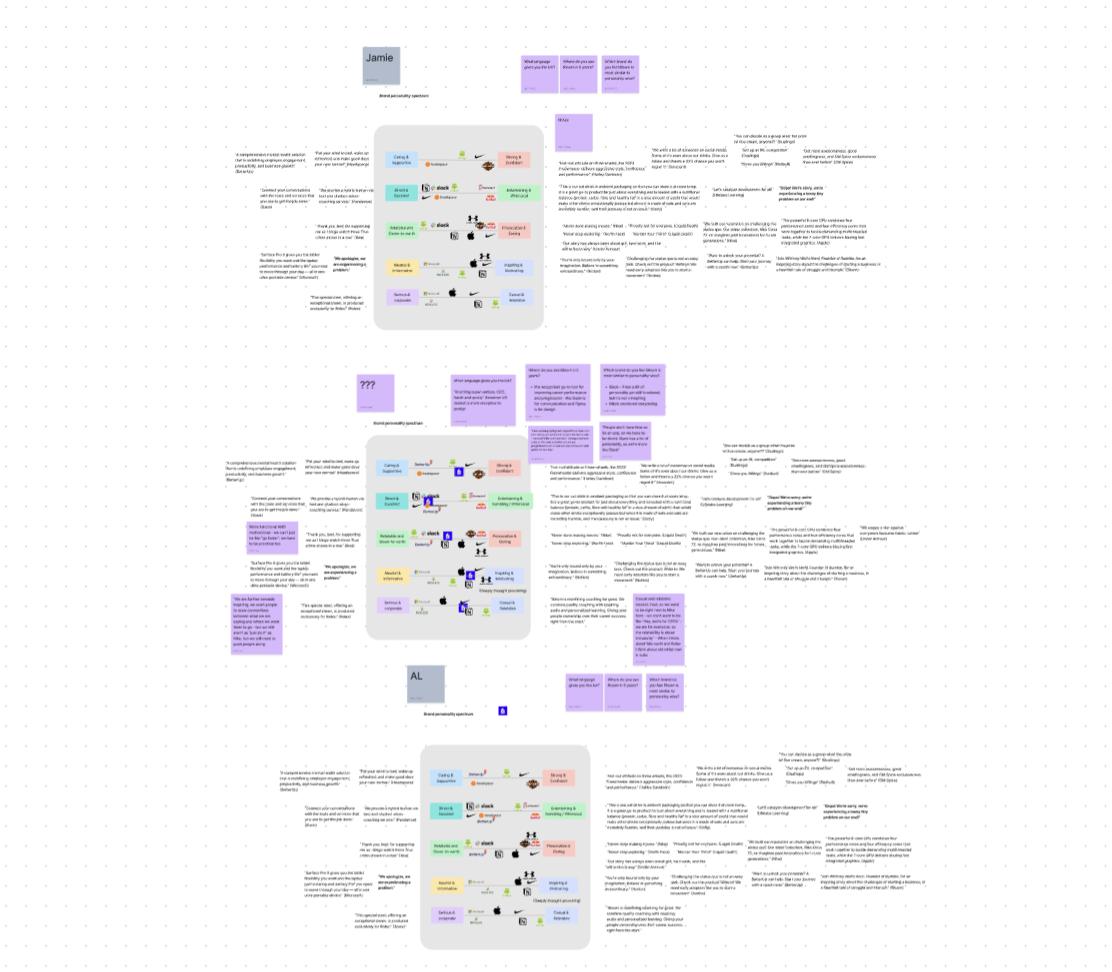
Energising careers for everyone
Industry
Technology
What I did
Brand Strategy, Verbal Identity, Content Design, UX Writing, Copywriting
01 - THE CHALLENGE
Bloom's mission is to scale career coaching to all employees. Entering an already crowded space, the challenge was to distinguish the brand from the mass of AI-driven career coaching apps and industry leaders like BetterUp.
02 - THE OPPORTUNITY
After a healthy bout of user testing, it became increasingly obvious that in order to create a better experience for employees, we needed to drastically simplify and more clearly explain the purpose and value of the product.


03 - THE PROCESS
To help Bloom disrupt the traditional career coaching model and deliver a go-to-market presence that stood out, we began by aligning on a shared vision: to create a brand and product experience that empowers employees to grow, thrive, and reach new heights at work.
We set out to define Bloom’s purpose, mission, values, and positioning, ensuring consistency across every touchpoint — from product content to team communications. The aim was to shift perceptions of career coaching from something static, elitist, or time-consuming, to something dynamic, inclusive, and always accessible.
Discovery & Research
Working alongside the product team, we kicked off with a discovery phase designed to uncover key user needs, test assumptions, and explore the brand’s role in people’s working lives.
DESK Research
I conducted a deep dive into Bloom’s existing research, alongside keyword trends and search behaviour using tools like Google Trends. This helped surface emerging themes in coaching, professional development, and workplace wellbeing.
USER TESTING
We ran a combination of moderated and unmoderated user interviews to understand how users experienced the current product, particularly the onboarding flow. These sessions revealed not only friction points but also emotional cues around tone, expectations, and perceived value. I used these insights to build out user needs, journeys, and empathy maps that guided later content and messaging work.
BENCHMARKING
To position Bloom effectively, I analysed both direct competitors (like BetterUp) and lateral inspiration across learning, gaming, and wellness (like Duolingo and Headspace). This helped identify opportunities to differentiate Bloom’s tone of voice and brand experience — by drawing on warmth, clarity, and energy not typically seen in the coaching space.
ALIGNMENT
I led a series of kick-off interviews with key internal stakeholders, including the CEO, Founder, Head of Growth, and Head of Coaching. These conversations uncovered early assumptions, surfaced internal perspectives on brand and culture, and laid the groundwork for a shared brand narrative. It also helped clarify how Bloom could show up for both users and teams, not just as a coaching platform, but as a genuine growth partner.
04 - THE SOLUTION
To reposition Bloom as a career growth partner, not just a coaching tool, we focused on reframing both the narrativeand the experience. A career isn’t simply a series of tasks in exchange for a paycheck —it’s personal. And career coaching isn’t just about scheduled 1:1 sessions. It’s the small, everyday moments of learning, reflection, and progress that help individuals reach new heights.
Our aim was to disrupt outdated models of coaching and instead build a more dynamic, accessible, and inspiring experience—one that felt intuitive from the first interaction.
Evolving the Language
User testing revealed several key mental models and language barriers that were affecting engagement and comprehension. We used these insights to refine terminology and bring more clarity, warmth, and precision to the product.
Key language updates included:
“Coaching app” → Reframed narrative: Users associated the term with mental health coaching, creating confusion. We shifted focus to growth, clarity, and performance.
“Workouts” → Removed/renamed: Fitness-related language created the wrong associations. We moved toward more neutral, career-relevant terms.
“Growth goals” → “Goals”: Simplified for clarity and to reflect user language.
“Bloom Experts” → “Bloom Leaders”: We elevated the title to convey authority and thought leadership more clearly.
Avoided wellness tropes: We deliberately stayed away from wellness or therapy-adjacent language to keep the product clearly focused on professional development.
Softened tone: Phrases like “commit to success” felt too aggressive. We introduced a warmer, more inclusive tone to make users feel encouraged, not pressured.
Added value propositions early: Lack of clarity around benefits was affecting conversion. We made sure Bloom’s value was visible before users reached the coach booking stage.
Improving the UX Flow
Content and flow were deeply intertwined in this project. One of the major friction points we uncovered was in the onboarding experience. While users were initially excited to sign up, that energy was lost due to the forced wait before accessing any content.
Key UX improvements included:
Interactive dashboard before coaching: We recommended building a dashboard that allowed users to explore the app, interact with content, and start learning before booking their first session. This preserved user momentum and gave people time to build trust.
Transparent session structure: Users mistakenly believed they could book unlimited sessions. We clarified the model, six strategic sessions per year, earlier in the journey.
Humanising the coaching experience: Users were hesitant about chat-only sessions and wanted to know who they’d be speaking to. We advised adding coach profiles, names, and photos to build connection and trust.
Through language refinement and thoughtful UX restructuring, we helped Bloom create an experience that felt empowering, approachable, and truly differentiated from traditional coaching models — supporting users in their day-to-day growth, not just formal sessions.
-

User personas
Using the personas we defined user motivations to help with improving the content across the UI screens in the overall Onboarding flow.
-

Information architecture
We gathered the most important content first and redesigned the flow to validate changes in the structure, also creating comms like the initial Welcome Email.
-

Testing the language
Since we had the ability to test user reactions and interactions, we had a lot of creative freedom to try new messaging and test the copy.
-

Exploring taxonomy
Defining Bloom’s product taxonomy was an ongoing process, like what to call the audio content, the speakers, and the exercises. Everything needed to be user-facing.
-

Creating consistency
Developing a content design system. Aligning in-product messaging with brand, value props and overall positioning to develop consistency throughout the entire experience.
-

Empathy maps
Creating empathy maps helped understand user and customer needs, for example, a manager would have very different needs to a more junior employee.
Mike Makasu, Chief Growth Officer, Bloom



